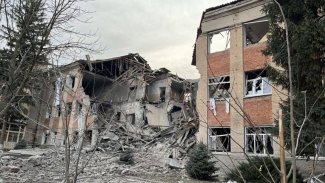Significant deliveries of Western heavy armaments. Day 330 of the war

On 19 January, on the eve of the next meeting of the contact group of countries offering militarily support to Ukraine (the so-called Ramstein group), representatives of 11 countries met in Estonia. Some of them announced new aid packages for the Ukrainian army and reported on their ongoing support projects:
- Denmark confirmed its earlier announcements that it would hand over 19 155-mm howitzers on CAESAR vehicle chassis, in agreement with France;
- Estonia promised to deliver dozens of 155-mm FH70 (along with thousands of rounds of ammunition) and 122-mm D-30 towed howitzers and security vehicles, as well as more than 100 Carl Gustaf M2 anti-tank grenade launchers (with more than a thousand rounds of ammunition for them); it will also provide training for the Ukrainian military. The total package is estimated to be worth €113 million;
- Lithuania intends to supply two Mi-8 helicopters (which will be replaced by US Black Hawk helicopters in 2024), 40 Bofors L/70 anti-aircraft guns, and ammunition. It estimates the value of these supplies at €125 million;
- Latvia is preparing to hand over two Mi-17 helicopters, dozens of Stinger portable anti-aircraft missile sets, dozens of machine guns and an equivalent number of drones. The first batch of the new weaponry is scheduled to depart for Ukraine on 25 January. Riga also intends to train 2000 Ukrainian soldiers;
- Poland has declared that it will deliver 57-mm S-60 anti-aircraft cannons and 70,000 cartridges for them. It will also transfer of another batch of 42 infantry fighting vehicles (IFVs) with training packages for two mechanised battalions, and continue to deliver 155-mm Krab self-propelled cannon howitzers with ammunition. According to some sources, all the 54 pieces Kyiv ordered have already arrived in Ukraine (Poland had previously transferred 18 of them free of charge); at least 9 of the Krabs have been destroyed or damaged in operations to date. Warsaw has also expressed its readiness to send a company of Leopard-2 tanks (14 vehicles) along with thousands of rounds of ammunition;
- The Czech Republic and Slovakia have said they are ready to increase their production of artillery systems and ammunition for the Ukrainian army;
- Britain confirmed its declarations of 16 January, according to which it will hand over to Kyiv a company of Challenger-2 tanks (14 units) with technical protection vehicles; 155-mm AS90 self-propelled howitzers (one eight-piece battery in the first instance, and two more in the longer term; London previously reported that it would deliver a total of 30 AS90s); about a hundred armoured personnel carriers (including tracked FV430 Mk3 Bulldogs) and Mine Resistant Area Protection (MRAP) vehicles; dozens of drones for diverting artillery fire; 100,000 artillery shells; ‘hundreds’ of guided missiles for multiple guided missile launchers (GMLRs) and anti-aircraft Starstreak and AMRAAM units; as well as spare parts for the tanks and IFVs used by the Ukrainian army. In addition, on 19 January London announced it would hand over more Brimstone anti-tank missiles (600 in number).
The new package of US military support (worth $2.5 billion) announced on 19 January included another 59 Bradley IFVs, along with 590 TOW anti-tank guided missiles and 295,000 25-mm cartridges, 90 Stryker wheeled armoured personnel carriers, 53 MRAPs, 350 HMMWVs, 12 ammunition vehicles, 22 artillery tractors, 8 Avenger anti-aircraft systems (with Stinger missile launchers installed on the HMMWV chassis), 20,000 rounds of 155-mm artillery ammunition and 600 guided missiles of the same calibre, 95,000 105-mm artillery shells, 11,800 120-mm mortar grenades, additional missiles for NASAMS, HIMARS launchers and HARM anti-radiation missiles, nearly 2000 anti-tank guided missiles and 3 million rounds of small-arms ammunition. Earlier, the Americans announced that they would not hand over any Abrams tanks to Ukraine. The US, in agreement with Israel, has begun delivering 155-mm artillery ammunition stored in the latter country (a total of 300,000 rounds, according to the New York Times). They will also send Ukraine ammunition from US bases in South Korea.
Sweden intends to deliver 50 CV90 IFVs, an unspecified number of 155-mm cannon howitzers on Archer vehicle chassis (earlier there were reports that 12 such pieces would be sent), as well as NLAW anti-tank guided missile launchers. Training the Ukrainian crews is expected to take several months. Canada intends to send another 200 Roshel Senator armoured cars (Kyiv has previously received 90 of these), with a package valued at $420 million. The Netherlands also declared that it would join the US and Germany in delivering Patriot air defence systems to Ukraine. According to the latter, the Dutch are expected to hand over a third battery of this type. Amsterdam also said it was ready to co-finance the supply of Leopard tanks. Finland has announced the delivery of a new package of military equipment worth an estimated €400 million. Its composition has not been made public, but it is known to include heavy armaments and ammunition. So far, Helsinki has provided Kyiv with military aid worth €190 million. On 16 January, Slovakia gave Ukraine the eighth and last of the 155-mm Zuzana-2 self-propelled howitzers it had promised. The KONŠTRUKTA-Defence company will prepare another 16 such weapons for the Ukrainian army, the production of which will be jointly financed by Denmark, Germany and Norway.
On 20 January, Germany confirmed the announcements it had made recently regarding the delivery of 40 Marder infantry fighting vehicles, a battery of its Patriot medium-range air defence system, seven Gepard self-propelled anti-aircraft guns (30 of which have so far been delivered) and another IRIS-T short-range air defence system with missiles. The new German defence minister confirmed that deliveries of Leopard tanks had been discussed at the Ramstein meeting, but no decisions were made.
Russian forces broke through the enemy’s defences in the Klishchiivka area and advanced to the western outskirts of Bakhmut, where they were halted in the Ivanivske area. Fighting also continues within the town limits and on its northern outskirts, for the villages at the exit of the roads from Bakhmut to Siversk and Slavyansk (Krasna Hora, Paraskoviivka). Russian units also crossed the Donets-Donbas canal and renewed attacks on the Ukrainian defenders’ positions east of Kostiantynivka (Oleksandro-Shultyne, Dyliivka). They also made further attempts to attack south and east of Siversk, west of Horlivka, in the area of Avdiivka, and in a wide arc west of Donetsk. In addition, they resumed attacks on enemy positions in the western part of the Donetsk oblast (Novosilka) and in two directions in the Zaporizhzhia oblast, where the most serious clashes occurred near Orichiv (Mala Tokmachka). Ukrainian forces also attempted attacks in the direction of Kreminna and in the western part of the Donetsk oblast.
Russia’s artillery and aviation are continuing to strike Ukrainian positions and facilities along the line of contact and in the border regions. Several dozen strikes a day have been launched at Kherson, Nikopol and Ochakiv, as well as the towns near them. Kramatorsk, Kupiansk, Lyman and the outskirts of Zaporizhzhia have suffered Russian rocket attacks. The effects of the recent strike on the country’s energy infrastructure are still becoming clear. On 17 January, Prime Minister Denys Shmyhal announced that nine power units at heating plants (including eight in the west of the country) and three substations had been damaged.
On 16 January, Ukrainian Military Intelligence (HUR) spokesman Andriy Yusov claimed that President Vladimir Putin had ordered the newly appointed commander of the occupation forces in Ukraine, Valery Gerasimov, to occupy the Donbas by March. The HUR representative believes that Putin is preparing his country for a protracted war. He noted that the Russian disinformation apparatus has been publicising various scenarios for a further offensive, including a possible naval landing in Odesa.
On 20 January British military intelligence estimated that the Wagner private military company had committed some 50,000 ‘volunteers’ to the war against Ukraine, in this way becoming a key element in the operation. Recently, the activities of the Wagner group have been gradually ‘legalised’. On 27 December 2022, the Russian Register of Business Entities reported that it had been officially registered as a legal entity, with its main field of activity being ‘management consulting’. This is likely aimed at maximising its commercial profits and further legitimising its work, as it is playing an important role in carrying out both military-related tasks and ensuring the security of Russian interests abroad.
According to the Ukrainian border service, there are 11,000 Russian military personnel in Belarus. This number changes from day to day due to the ongoing rotation of units that are being diverted to the Donbas oblast after training. In mid-January, six Su-34 bombers and two Su-30SM multirole fighters were sent to Belarus from Voronezh and Kursk airports. The total number of Russian aircraft and helicopters on its territory now stands at about 50. Most of them are deployed at two airfields: Machulishchy in Minsk oblast and Baranovichi in Brest oblast.
On 18 January, a helicopter crashed in Brovary near Kyiv under circumstances which remain unclear. Among those killed were Ukraine’s interior minister Denys Monastyrsky, his deputy Yevhen Yenin and state secretary for the interior ministry Yurii Lubkovych. The ministry’s leadership had planned to hold an inspection on the front line in the Kharkiv oblast. According to a communiqué from the Emergency Situations Service, 14 people (including three children) were killed and 29 (including 15 children) were injured as a result of the helicopter’s crash and explosion near a local kindergarten. The Security Service of Ukraine, which is conducting the investigation, has accepted three basic possible causes of the incident: a violation of flight safety rules, a technical failure or the intentional actions of third parties (sabotage). The circumstances of the crash will also be investigated by a government commission.
A meeting between the Russian foreign minister Sergei Lavrov and Belarusian president Alyaksandr Lukashenka took place in Minsk on 19 January. The latter stated that Moscow should not doubt Minsk’s support on security issues, and that Belarus would guarantee that Russian troops could operate on its territory. He also noted that Ukraine’s attitude (Kyiv has avoided provoking Belarus directly) has “pleasantly surprised him”. Lavrov announced that the strengthening of NATO military structures on the two countries’ borders will not go without a response from Moscow and Minsk, and that the two capitals have a common position on what the goals of the Russian special military operation in Ukraine are. He also stressed the importance of bilateral military-technical cooperation, and announced that he had signed a memorandum with his Belarusian counterpart Sergei Aleinik on strengthening biosecurity. The two parties will take steps to reduce the threats in this area from the activities of third countries’ military departments.
Commentary
- The announcements of heavy weapons deliveries to Ukraine ahead of the next meeting of the so-called Ramstein group (scheduled for 20 January) represent a significant move to meet the needs of the Ukrainian army. Including the previous support package which Washington presented on 6 January (including 50 IFVs, 100 tracked transporters and 18 self-propelled howitzers), in the coming weeks and/or months Kyiv will receive armaments and military equipment which will allow it to fully equip at least four mechanised battalions with IFVs (a total of 200 vehicles from the US, Sweden and Germany), five battalions with armoured personnel carriers (around 250 units from the US and the UK) and five artillery squadrons (more than 100 155-mm calibre howitzers from Denmark, Estonia, Sweden, the US and the UK) with leftover reserve equipment.
- The Ukrainian army’s two or three all-military brigades lack the equipment to fully rearm their tank battalions to Western standards. If London and Warsaw make good on their promises to send Challenger and Leopard tanks respectively, that would allow Ukraine to field a total of only two companies. Paris’s possible transfer of Leclerc tanks, which it is presently considering, would also involve no more than a company. In the case of the Leopard tanks, Berlin continues to block other countries from issuing permits to supply them; nor does it want to supply tanks from the resources of the Bundeswehr and German industry, although it has not ruled out doing so in the future.
- The deliveries announced will reduce the shortage of heavy armaments in the Ukrainian army, but are still insufficient for the defenders’ needs. In mid-December, Kyiv’s shortfall was estimated at 300 tanks, 600–700 IFVs and 500 howitzers, but early January saw an intensification of Russian offensive operations in the Donbas; Ukrainian sources have admitted that this resulted in heavy losses for their side. It remains unclear how much Kyiv’s needs will have increased by the end of February, when the first units of new armaments are likely to start arriving in the country.
- Lukashenka’s attitude during his talks with Lavrov confirms that Belarus will continue to support Russian military activity on its territory. He pointed out that both sides have first and foremost emphasised the increase in the alleged threat from NATO, with issues related to the ‘special operation’ in Ukraine coming only second. Lukashenka’s statement that Kyiv is not provoking Belarus indicates that the regime in Minsk intends to avoid getting its own army directly involved in the frontline fighting. On the other hand, it will continue to provide support to Russian forces, not only by providing its own military facilities or material reserves, but also by intensifying cooperation between the two countries’ arms companies.





